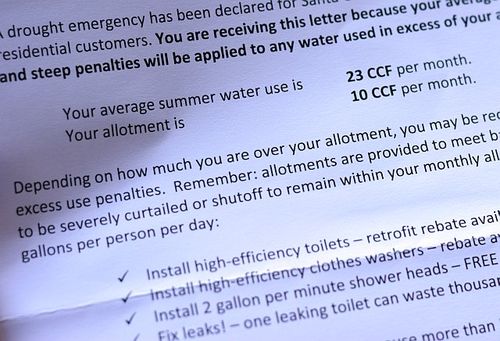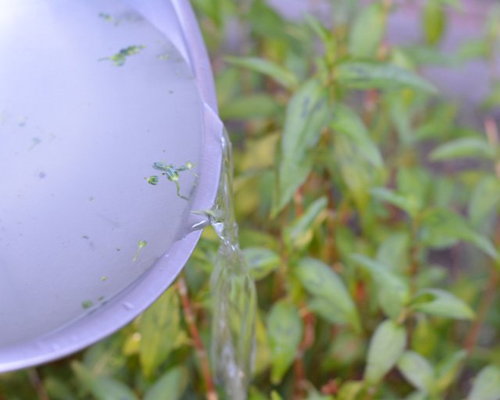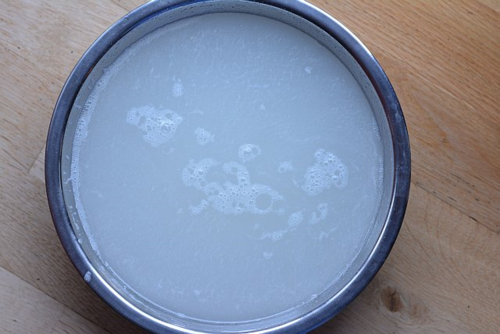
The letter from the city arrived last week. We knew that it would but fantasized that it wouldn’t. The finality was clearly printed on paper: “Rationing will begin May 1st for all residential customers. You are receiving this letter because your average summer consumption is over your allotment, and steep penalties will applied to any water used in excess of your allotment.”
The City of Santa Cruz where I live relies up on a local water supply. We don’t tap into the California water supply system like many other municipalities in the state. Striking a blow for water freedom and independence has its price and this was it.
The letter said that our average monthly summer use was more than double our allotment. Okay, we had a couple of leaks in our sprinkler system last year and got them fixed; we weren’t water wastrels as the city made us out to be. The allotment is not unrealistic and actually generous for our household of 2, but unless we conserve, we won’t be able to water our back and front yard plants at all. They’re drought tolerant but to a certain extent only. Additionally, we hope to embark on a bathroom remodeling project that will likely use a fair amount of water. I don’t want to be a water Nazi to a contractor.
After digesting the reality of rationing, I got obsessed with replacing our home appliances with water- and energy-saving ones. Dishwashers, clothes washers, water heaters, toilets, faucets – I studied up on them. Turns out that replacing our appliances costs a bundle and figuring out what qualifies for energy saving rebates is no easy feat. (As a side note, peruse online sources but go to an old fashioned appliances sales places like Sears for consultation/reconnaissance on home appliances.)
We haven’t decided on the appliance thing but my husband and I did come up with ideas to save water around the house. We’ll set a bucket in the shower to collect water as the shower water heats up, take shorter showers consecutively so we don’t waste hot water, and flush less (you know what I mean). In the kitchen, my drought tolerant cooking strategies include:
Wash vegetables in a bowl of water. This is something my family used to do: partially fill a bowl with water to wash vegetables during food prep. I’d gotten into the wasteful habit of holding individual leaves of lettuce under a stream of water instead of immersing all the leaves in water at once. The vegetables get washed in order of the relatively clean (tomato or green onion) to potentially super dirty (lettuce or spinach).
Repurpose water for plants. Instead of pouring the water used for washing vegetables down the drain, I water our plants with it. It’s not like that water is greywater that has to get fully recycled to be reused. Most of our produce comes from the local farm so heck, we’re helping to complete the circle. Leftover water in a pitcher, flower vase, and Mr. Spring Roll rice paper dipping bowl gets poured into garden beds too.
Rinse rice then rinse skin. We make rice 3 or 4 times a week and it seems wasteful to dump the rinsing water down the sink. I collect it in a bowl and water plants with it. My mom told me that rice rinsing water is suppose to be good for the skin, so I occasionally wash my hands or face with it; the beige rice rinsing water is nice because it’s partially hulled. Because there’s starch in that water, you can use some of it to lightly thicken a soup or sauce (think of how you save pasta cooking water to use as a binder). See the comments below for Betty Ann Besa-Quirino's Filipino take on hugas bigas!
Spray versus stream of water. At a home builders convention in February, I asked a Kohler representative about whether the spray nozzle on the kitchen faucet used less water than the stream of water. The water flowed at the same rate so she wasn’t sure. I somehow think that you use less water with the spray as it seems to knock stuff off dirty dishes quickly. What do you think? I’m not about to put an aerator on my kitchen faucet to save water but I will use the spray more often.
Double duty dishwashing. If there’s a large pot that needs washing, I fill it with sudsy water to soak and while that’s happening, rinse my dishes in the pot before putting them in the dishwasher. I know that sounds kinda gross but it saves water.
Make a pot of water count. Cooking Asian food often involves blanching, parboiling or boiling several ingredients. To do that efficiently, I bring a 3 or 4-quart covered pot of water to a boil and use it to cook prepped ingredients. I order the ingredients from the benign (carrots or asparagus) to the potent (noodles or protein). Broccoli can turn the water smelly funky and affect other ingredients so I tend to cook it fast and last. This can be a little tricky at first so think about each ingredient and how it’ll affect the water it’s cooked in.
Use less water to boil pasta. Many pasta boxes and recipes say to boil noodles in an ample amount of boiling water but you can use a little less. In 2009 food scientist Harold McGee wrote a New York Times piece questioning the notion of cooking pasta in lots of boiling water. He suggested starting the noodles in cold salted water (say 1 pound plus 2 teaspoons salt in 2 quarts of water). It worked without lost of flavor or texture. Asian noodles cook quickly so I tend to use the 1 pot for many ingredients method above. But with pasta, I'd give Harold's method a try, especially on a relatively big burner on your stove.
May 1st is not far away and we’re hoping to do our part. We were stressed out about water rationing but then we came up with doable strategies to get us through the next several months. It’s a matter of being mindful about something we often take for granted.
What are your ideas for saving water?
Relates VWK posts and links:



















